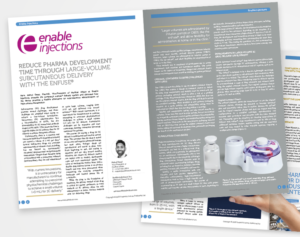
Reduce Pharma Development Time: Large-Volume Subcutaneous Delivery with the enFuse
Subcutaneous (SC) drug development presents several challenges, and these challenges are amplified when trying to achieve a low-volume formulation. Intravenous (IV) administration has a bioavailability of 100%, but the bioavailability for SC monoclonal antibody drugs is 60%–80%. This means the dose is typically higher for SC delivery than for IV delivery to achieve therapeutic efficacy.
Unfortunately, there is a common and inaccurate belief that SC drug delivery should not exceed a volume of 3 mL per dose. Several well-known drugs are available subcutaneously at volumes >3 mL, including, but not limited to, trastuzumab, rituximab, daratumumab, and pertuzumab/trastuzumab. Despite these therapies being co-formulated with a permeation enhancer (hyaluronidase), they are still administered at quite large volumes, ranging from 5–15 mL, and delivered over several minutes. With current innovations, it is unnecessary for manufacturers to continue attempting to overcome physicochemical challenges to achieve a small volume (<3 mL) for SC delivery. Formulation challenges can be expensive and time-consuming, delaying convenient, life-saving treatments for patients.
The process for storing a drug for SC delivery is multifaceted and involves several steps. The container that the drug is stored in can vary and requires substantial testing, but most often, biologic drugs are manufactured and stored in glass vials. From beginning to end, this testing is expensive and can take several months; therefore, the chosen SC delivery method can impact time to market, development costs and even commercial uptake. The value of reaching the market faster with a flexible drug delivery format is an obvious benefit and even more pronounced when considering the evolving competitive landscape and limited patent life of a molecule.
While the drug is the foundation of treatment, the delivery method of the drug is critical for patient preference, as some methods of SC delivery allow for self-administration at home. Various methods exist for delivering drugs and they commonly include prefilled syringes, autoinjectors, infusion pumps and, more recently, on-body delivery systems (OBDS). However, larger volumes are administered by infusion pumps or OBDS, like the enFuse, and allow flexibility for administration at home or in the clinic.
These methods vary in complexity of development due to certain requirements with container and formulation stability. This article focuses on the impact of formulation changes and container closure systems on development time, as well as touching on patient preference.
